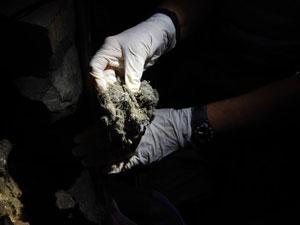The expression "a little bit goes a long way" can be applied to lots of items, and that's certainly the case when it comes to lint. A small pile of the fluffy stuff may merely be an annoyance at home, but the amount of lint left behind by nearly 400,000 annual visitors to the caves at Carlsbad Caverns National Park can add up to a real problem.
Whether it's the handful of lint you pull off the filter in your clothes dryer'or the amazing pile of dust bunnies you discovered when you looked under the guest room bed for the first time in a year'it would take a lot of that stuff to total a single pound. That said, it's hard to imagine a pile of over 51 pounds of lint.
That's the total amount of the tiny bits of debris removed from cave formations and along trails in Carlsbad Cavern by a crew of 22 volunteer "lint pickers" during 447 hours of work earlier this month.
The effort was part of an annual "Lint Camp" that's been held at the park for 26 years. Statistics for the work are available beginning in 1988, and since that time, 386 volunteers have collected an amazing 495 pounds of lint during over 8,000 hours of work in the caves.
The majority of this work is performed in the park's primary attraction, Carlsbad Cavern, since that large cave receives most of the area's visitation, and hence most of the lint. Just for clarification, Carlsbad Caverns National Park also includes numerous other caves, part of a system of over 300 limestone caves in the vicinity.

Volunteers removed over 51 pounds of lint from the cave this year, one small bag at a time. NPS photo.
Okay, so lint is a nuisance at home, but in an cave as large as Carlsbad Cavern, is it really a problem?
The answer is a definite "yes," for several reasons. About 380,000 people visit the park each year, and during their hikes into the park's caves they unintentionally leave behind items such as fabric fibers, hairs, skin cells, dust, and other foreign particles.
If it's not removed, all of this unnatural material can become cemented into cave formations as water deposits calcite over old lint deposits. The result is discoloration of natural cave surfaces, and given enough time, even damage to the delicate cave formations'some microbes which eat the organic matter in lint produce an acid that dissolves rock.
Lint may be inanimate, but that doesn't mean it can't travel a considerable distance. At Lehman Cave, in Great Basin National Park, staffers and volunteers conducting a similar cleanup found that air currents caused lint deposition as high as 30 feet off the ground, and some of the soda straws and stalactites in that cave were literally shrouded in lint.
Valerie Gohlke, public affairs specialist at Carlsbad Caverns, notes that removing the lint "is tedious and time-consuming work. Without the effort of groups like the Lint Pickers, staff at the caverns could not protect the resource as effectively. The park is very thankful to the volunteers for their dedication and hard work protecting this beautiful underground resource."




Comments
But wait . . . . there are people out there who claim that humans have no impact upon our planet and can't possibly be causing any significant changes to this wobbly old sphere upon which we depend for everything.
This is just one of many visible refutations of that argument.
All a person has to do is open their eyes. And ears. And nose.
But ignoring the challenges our spaceship faces is so much easier and less expensive. . .
Really? Who? Name one.
Is that crickets I hear chirping?